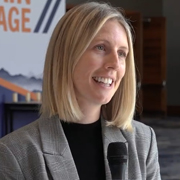ARTIFICIAL INTELLIGENCE
Swiss Re Growth and Innovation Lead: Responsible AI Use Stresses Explainability and Bias Prevention
DENVER //BestWire// - Jillian Badanes, growth and innovation lead, Americas, Swiss Re, cautioned against technology-first approaches, stressing the importance of understanding business processes and involving key stakeholders in artificial intelligence implementation. Badanes spoke with AM Best TV at NAMIC's 129th Annual Convention, held in Denver.
 Jillian Badanes
Jillian BadanesView the video version of this interview here.
Following is an edited transcript of the interview.
Q: You presented here at the conference yesterday. Can you tell us a little bit about the message that you shared?
A: It was a panel about AI and I think the message I hope to convey is that AI is here, it's really the future. Carriers do need to invest, but they should think about what makes sense for them and not just start with a tech-first approach, but think about the business problems, think about their business strategy, and then look for use cases that make sense for them.
Q: How can mutual insurers leverage advancements in AI and machine learning to enhance underwriting accuracy, and customer service?
A: There's a lot of opportunity, and AI is kind of a broad spectrum of capabilities, but you think about a lot of things that underwriters are spending their time on that just probably are frustrating to them and aren't the best-value add based on their skill set. Things like data entry, going back and forth with agents, searching on the internet to validate information. A lot of that can be made more efficient with the help of AI and allow underwriters to spend their time doing the things that they really do best, the analysis, the evaluation, the critical thinking.
Q: How can mutual insurers leverage AI to better predict catastrophic risk and also improve modeling accuracy?
A: There's a lot of exciting developments in terms of catastrophe modeling. One thing I spoke about yesterday was wildfire, for example. It's a dynamic peril that is really based on changing weather patterns and local conditions. It's hard for traditional catastrophe models to understand those complex interactions of these different variables, but AI can.
We've recently launched a partnership with Google's innovation arm, where they've built an AI -based model for wildfire that considers 600 different variables and the complex interaction of those variables year over year to forecast the probability of a wildfire occurring one or five years in the future. It's really unlike anything in the market. We brought it into our cat net platform to make it available for underwriters. We expect that a lot of catastrophe models will evolve to include this sort of AI.
Q: What are some of the pitfalls to avoid when using AI?
A: As I mentioned, one is starting with the technology first. Very important to think about first, the business problem, how does the process look today? Who are the people involved? And spend time getting to know them and their needs and involve them in the design process with the technologists. I think that's a key one and is a key part of the success we've seen.
The other is really considering the responsible use of AI and how can you make sure that these models are designed for explainability, make sure that they're free from bias. These are sort of things that are coming up in the models and developing a rigorous review process is really critical and it's a space that we've been working on and supporting our clients in.
Q: How is Swiss Re leveraging innovation to create new reinsurance solutions that address the evolving needs of insurers in the Americas, particularly in emerging risk areas?
A: I'm the innovation lead for the Americas, so it's a big part of my job. A key part is making sure first we understand what are the needs of our clients? Again, taking that really customer-centric approach. We look at where sort of the trends in the industry, what are key pain points for our clients, what comes up again and again, and we start there.
We spend a lot of time working with them, better understanding the needs, their priorities, and then look at how we can bring in cutting-edge technology. That might be things that we've developed internally for ourselves. In some cases, we have solutions that we've kind of brought to our clients that way.
We also look at the capabilities of AI, of data analytics, and think about what we can do bespoke for clients. We try to take a very iterative approach, so we start small, we build a prototype, we test, we get feedback, and if it works, then we continue to invest and roll out. Really side-by side with our clients.
View this and other interviews at http://www.ambest.tv
(By Lori Chordas, senior associate editor, AM Best TV: Lori.Chordas@ambest.com)